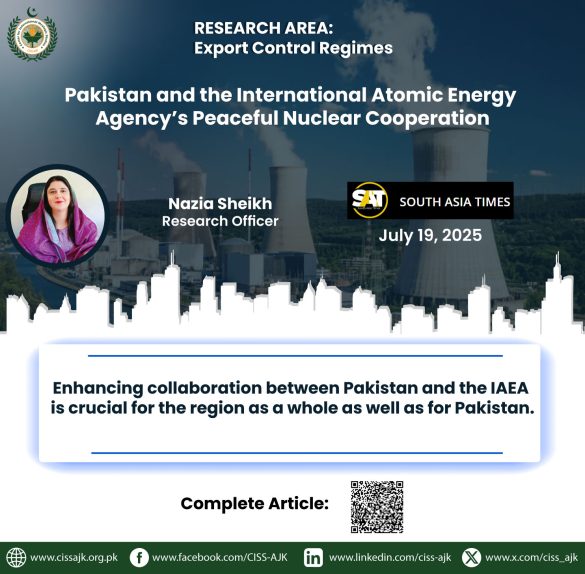The International Atomic Energy Agency (IAEA) was created in 1957 to promote the peaceful application of nuclear technology. The Agency has been instrumental in helping member states advance scientific research for civilian applications, establish safeguards, and develop robust nuclear safety frameworks. Pakistan, a nuclear-capable nation and one of the IAEA’s founding members, has developed a long-standing and strategic collaboration with the Agency, supported by active participation, technical assistance, and a strong dedication to the peaceful use of nuclear energy. Pakistan recognized the revolutionary potential of nuclear technology and joined the IAEA shortly after its founding. It then started a civilian nuclear program aimed at improving energy production, agriculture, and medicine.
Key Areas of Cooperation
The collaboration between Pakistan and the IAEA has increased over time, and Pakistan is now assisting other nations with the IAEA’s regulations. In several areas, including energy, agriculture, regulatory affairs, and health, Pakistan is collaborating with African countries as part of the 2021 practical arrangements. Three extensive technological cooperation projects are currently being implemented in the fields of nuclear power development, human health, and food and agriculture. Pakistan has been able to significantly expand the benefits of nuclear technology for its people and economy due to this strong collaboration. Currently, the Pakistan Atomic Energy Commission (PAEC) operates 19 cancer facilities that utilize state-of-the-art techniques, including gamma CT, LINAC, Cyberknife, and Theranostics, to treat approximately 80% of the country’s cancer caseload. Scientists from Pakistan’s Nuclear Institute for Agriculture and Biology (NIAB) have collaborated with the IAEA to develop climate-resistant seeds and crops, which are expected to yield more nutrient-dense food crops and sustainable cotton varieties. Two Pakistani institutions are also acknowledged as IAEA collaborating centers for training, education, and technical assistance: the National Institute of Safety and Security and the Pakistan Institute of Engineering and Applied Sciences.
Leadership and Governance within the IAEA
Pakistan also frequently participates in the Agency’s decision-making process. At the 68th session of the IAEA’s General Conference in Vienna in 2024, Pakistan was elected to its 21st term as a member of the IAEA Board of Governors, for a two-year term from 2024-2026. By this selection, Pakistan’s long-time commitment to the IAEA’s objectives and aims in promoting the peaceful use of nuclear energy is acknowledged, which also serves as a productive contribution to the advancement of the IAEA’s initiatives and policies. Additionally, Pakistan was also elected as the president of the 10th review meeting in the Convention on Nuclear Safety. Under the President of the Tenth Review Meeting, Pakistan’s responsibilities include supervising the review procedure and promoting openness between the contractual parties. This appointment serves as testament to the world’s confidence in Pakistan’s exceptional record of nuclear safety and security, with no objections. Pakistan has proved over the years that it is a responsible country regarding nuclear safety and security, by guaranteeing that its civilian nuclear power plants are operated by strict safety regulations under the IAEA statute. Pakistan has a long history of participation in CNS, and this election acknowledges Pakistan’s contribution to nuclear safety laws both domestically and internationally.
High-Level Endorsements and Visits
DG IAEA Rafael Mariano Grossi, during his first visit to Pakistan in Feb 2023, praised Pakistan’s “world-class and impeccable nuclear safety record”. This visit highlighted a productive discussion on peaceful uses of its nuclear capacity with the country’s leadership, and he also visited several key nuclear facilities across the country. In the same vein, during his second visit to Pakistan in February 2025, he described Pakistan’s nuclear power generation programme as one of the most successful in the world. He also visited the under-construction Chashma Power Plant unit 5 (C-5). The visit focused on expanding cooperation between Pakistan and the IAEA, particularly to mitigate climate change through the peaceful use of nuclear technology.
Future Ambitions and Energy Goals
Currently, Pakistan has six nuclear power reactors in Karachi and Chashma, capable of generating 3,262 MW of electricity. A quarter of Pakistan’s energy demand will be met by 32 nuclear power stations with a combined capacity of 40,000 MW, according to the country’s Nuclear Energy Vision 2050. To accomplish this, collaboration with the IAEA would be essential. This will also help the energy sector reach its 2050 target of having zero carbon emissions. Overall, Pakistan’s nuclear power facilities are currently safeguarded by IAEA regulations. Pakistan is now able to assist other nations in achieving the Sustainable Development Goals. Its civil nuclear program is a testament to careful planning and successful international cooperation after years of steadfast work. In addition to powering homes and businesses, Pakistan’s civil nuclear program promotes improvements in agriculture, medicine, and climate resilience.
The Path Forward
Enhancing collaboration between Pakistan and the IAEA is crucial for the region as a whole as well as for Pakistan, as the IAEA would assist in meeting our growing energy needs. Under safeguards, the IAEA would facilitate easier access to modern reactor technologies. The IAEA’s support for water management, medical innovation, and climate-resilient agriculture aligns with Pakistan’s development objectives.
The views expressed in this article are the author’s own. They do not necessarily reflect the editorial policy of the South Asia Times.



